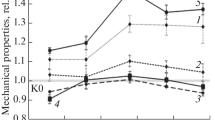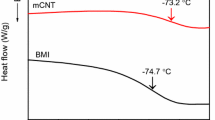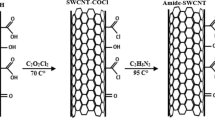Abstract
This study deals with the preparation of carboxylated styrene butadiene rubber (XSBR)/multiwall carbon nanotubes (MWCNTs) nanocomposites prepared in the latex form by means of a ball mill. Two types of CNTs, i.e., non-functionalized and OH-functionalized (CNT–OH) were used. The rheological properties, FTIR spectrums, SEM micrographs and stress relaxation experiments were exploited to evaluate the resulting nanocomposites. For a given frequency, both the viscosity and storage modulus increased as the concentration of CNT was augmented with the greatest value for the nanocomposites loaded with CNT–OH. The viscosity of nanocomposites exhibited a shear thinning behavior throughout applied frequency and indicated a power law index of about n = 0.22. Nanocomposite ATR analyses revealed the presence of physical interaction of H-bonding type between hydroxyl group of CNT–OH and carboxyl group of XSBR for XSBR–CNTOH nanocomposites. A mechanism based on the chemistry of medium was proposed to explain the development of H-bonding. SEM micrographs confirmed the uniformity of carbon nanotubes dispersion in the resulting microstructure. A two-step innovative stress relaxation experiment was performed on the prepared nanocomposites through which the resulting microstructure of nanocomposites was further explored. The relaxation behavior of nanocomposites (both in first and second steps) were modeled and well predicted using Prony series and the parameters of generalized Maxwell equation for stress relaxation, \( \tau_{i} \) and \( g_{i} \) were computed, as well.




















Similar content being viewed by others
References
Huang YY, Ahir SV, Terentjev EM (2006) Dispersion rheology of carbon nanotubes in a polymer matrix. Phys Rev B 73:1–9
Ivanov E, Kotsilkova R, Krusteva E, Logakis E, Kyritsis A, Pissis P, Silvestre C, Duraccio D, Pezzuto M (2011) Effects of processing conditions on rheological, thermal, and electrical properties of multiwalled carbon nanotube/epoxy resin composites. J Polym Sci, Part B: Polym Phys 49:431–442
Via MD, Morrison FA, King JA, Caspary JA, Mills OP, Bogucki GR (2011) Comparison of rheological properties of carbon nanotube/polycarbonate and carbon black/polycarbonate composites. J Appl Polym Sci 121:1040–1051
Yan XL, Gong Z, Gong J, Gao S, Zhang Z, Wang B (2012) Investigation of the rheological and conductive properties of multi-walled carbon nanotube/polycarbonate composites by positron annihilation techniques. Carbon 50:2899–2907
Cheng HKF, Pan Y, Sahoo NG, Chong K, Li L, Chan SH, Zhao J (2012) Improvement in properties of multiwalled carbon nanotube/polypropylene nanocomposites through homogeneous dispersion with the aid of surfactants. J Appl Polym Sci 124:1117–1127
Kim M, Mun SC, Lee CS, Lee MH, Son Y, Park OO (2011) Electrical and rheological properties of polyamide 6, 6/γ-ray irradiated multi-walled carbon nanotube composites. Carbon 49:4024–4030
Rahmatpour A, Kaffashi B, Maghami S (2011) Preparation and rheological properties of functionalized multiwalled carbon nanotube/waterborne polyurethane nanocomposites. J Macromol Sci Part B Polym Phys 50:1834–1846
Pötschke P, Fornes TD, Paul DR (2002) Rheological behavior of multiwalled carbon nanotube/polycarbonate composites. Polymer 43:3247–3255
Du M, Guo B, Lei Y, Liu M, Jia D (2008) Carboxylated butadiene–styrene rubber/halloysite nanotube nanocomposites: interfacial interaction and performance. Polymer 49:4871–4876
Peterson SC, Jong L (2008) Effect of wheat flour pre-cooking on the composite modulus of wheat flour and carboxylated styrene–butadiene latex. Compos Part A Appl S 39:1909–1914
Pietrasik J, Gaca M, Zaborski M, Okrasa L, Boiteux G, Gain O (2009) Studies of molecular dynamics of carboxylated acrylonitrile-butadiene rubber composites containing in situ synthesized silica particles. Eur Polym J 45:3317–3325
Jubete E, Liauw CM, Allen NS (2007) Water uptake and tensile properties of carboxylated styrene butadiene rubber based water born paints: models for water uptake prediction. Prog Org Coat 59:126–133
Stephen R, Alex R, Cherian T, Varghese S, Joseph K, Thomas S (2006) Rheological behavior of nanocomposites of natural rubber and carboxylated styrene butadiene rubber latices and their blends. J Appl Polym Sci 101:2355–2362
Blackley DC (1997) Polymer latices, chap 1. Springer, UK, pp 15–17
Hirscher M, Becher M, Haluska M, Von Zeppelin F, Chen X, Dettlaff-Weglikowska U, Roth S (2003) Are carbon nanostructures an efficient hydrogen storage medium? J Alloys Compd 356:433–437
Awasthi K, Kamalakaran R, Singh AK, Srivastava ON (2002) Ball milled carbon and hydrogen storage. Int J Hydrogen Energy 27:425–432
Li YB, Liang J, Wei BQ, Liang J, Yu Q, Wu DH (1999) Transformation of carbon nanotubes to namnoparticle by ball milling process. Carbon 37:493–497
Ma PC, Wang SQ, Kim J-K, Tang BZ (2009) In situ amino functionalization of carbon nanotubes using ball milling. J Nanosci Nanothecno 9:749–753
Macosko WC (1994) Rheology principles, measurements and applications, Chap 4. USA, pp 134–174
Gent AN (2001) Engineering with rubber how to design rubber components, chap 4. Hanser, USA, pp 74–78
Sperling LH (2006) Introduction to physical polymer science, chap 5. Wiley, USA, pp 217–218
Stuart B (2004) Infrared spectroscopy fundamentals and applications, chap 3. Wiley, UK, pp 49–53
Otera J, Nishikido J (2010) Esterification methods, reactions, and applications, chap 1. Wiley, Germany, pp 11–13
Sykes P (1985) A guidebook to mechanism in organic chemistry, chap 1. Wiley, USA, pp 19–21
Vaisman L, Wagner HD, Marom G (2006) The role of surfactants in dispersion of carbon nanotubes. Adv Colloid Interface Sci 128–130:37–46
Rausch J, Zhuang R-C, Mäder E (2010) Surfactant assisted processing of carbon nanotube/polypropylene composites: impact of surfactants on the matrix polymer. J Appl Polym Sci 117:2583–2590
Ferry JD (1980) Viscoelastic properties of polymers, chap 4. Wiley, New York, pp 47–69
Mottahedi M, Dadalau A, Hafla A, Verl A (2011) Integrated systems, design and technology, chap 8, 1st edn. Springer, New York, pp 79–91
Chen T (2000) Determining a prony series for a viscoelastic material from time strain data. NASA/TM-210123 ARL-TR-2206
Ghoreishy MHR (2012) Determination of the parameters of the Prony series in hyper-viscoelastic material models using the finite element method. Mater Design 35:791–797
Ha J (2008) Carbon black filler reinforcement of elastomers. A thesis submitted to the University of London
Chhabra RP, Richardson JF (2008) Non newtonian flow and applied rheology, chap 1. Butterworth-Heinemann, UK, pp 38–41
Acknowledgments
This study was financially and spiritually supported by Iran Polymer and Petrochemical Institute, Iran.
Author information
Authors and Affiliations
Corresponding author
Rights and permissions
About this article
Cite this article
Alimardani, M., Abbassi-Sourki, F. & Bakhshandeh, G.R. Preparation and characterization of carboxylated styrene butadiene rubber (XSBR)/multiwall carbon nanotubes (MWCNTs) nanocomposites. Iran Polym J 21, 809–820 (2012). https://doi.org/10.1007/s13726-012-0087-1
Received:
Accepted:
Published:
Issue Date:
DOI: https://doi.org/10.1007/s13726-012-0087-1




